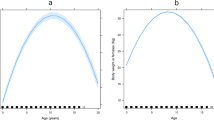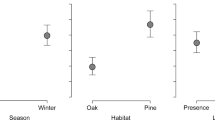Abstract
Body condition integrates the effects of habitat on individuals and consequently population performance of cervids. However, most condition data is likely to come from harvested males, which may not reflect absolute condition of, or habitat quality for, adult females because of basic ecological differences. To test whether condition of males reflected condition of females, we compared three indices of nutritional condition (rump body condition score, maximum subcutaneous fat thickness, and percent body fat) of adult male, lactating adult female, and dry adult female mule deer over multiple years in 2 sites in New Mexico, USA. Males consistently achieved significantly higher levels of condition than females for all indices of condition, regardless of whether indices for males were scaled for metabolic size or not. Because population productivity and rate-of-increase is driven by condition and consequent performance of females, population monitoring strategies that assess only condition of males may not reflect absolute condition of females and thus habitat quality as it fundamentally relates to population dynamics of cervids. Condition of males, however, can likely index relative habitat quality if not absolute.

Similar content being viewed by others
References
Andersen R, Duncan P, Linnell JDC (eds) (1998) The European roe deer: the biology of success. Scandanavian University Press, Oslo
Bender LC (2006) Uses of herd composition ratios in ungulate management. Wildlife Soc Bull 34:1225–1230
Bender LC (2015) Does body condition affect immediate post-capture survival of ungulates? Human-Wildlife Interact 9:191–197
Bender LC (2018) Basics of trophy management (revised). Guide L-111. Cooperative Extension Service, New Mexico State University, Las Cruces
Bender LC (2020) Elk, deer, and pinyon-juniper: needs, what works, and what doesn’t. In: Malcolm K, Dykstra B, Johnson K, Lightfoot D, Muldavin E, Ramsey M (comps) Symposium proceedings on piñon-juniper habitats: status and management for wildlife-2016. Proceedings RMRS-P-77. U.S. Forest Service, Rocky Mountain Research Station, Ft. Collins, pp 34–58
Bender LC, Hoenes BD (2017) Costs of lactation to body condition and future reproduction of free-ranging mule deer. Mammalia 81:329–338
Bender LC, Hoenes BD (2018) Age-related fecundity of mule deer in south-central New Mexico. Mammalia 82:124–132
Bender LC, Rosas-Rosas OC (2016) Compensatory puma predation on adult female mule deer in New Mexico. J Mammal 97:1399–1405
Bender LC, Hoenes BD, Rodden CL (2012) Factors influencing survival of desert mule deer in the greater San Andres Mountains, New Mexico. Human-Wildlife Interact 6:245–260
Bender LC, Lomas LA, Browning J (2007) Condition, survival, and cause-specific mortality of adult female mule deer in north-central New Mexico. J Wildlife Manage 71:1118–1124
Bender LC, Boren JC, Halbritter H, Cox S (2011) Condition, survival, and productivity of mule deer in semiarid grassland-woodland in east-central New Mexico. Human-Wildlife Interact 5:276–286
Bender LC, Carlson E, Schmitt SM, Haufler JB (2002) Production and survival of elk (Cervus elaphus) calves in Michigan. Am Mid Nat 148:163–171
Bender LC, Boren JC, Halbritter H, Cox S (2013) Effects of site characteristics, pinyon-juniper control, and precipitation on habitat quality for mule deer on the Corona Range and Livestock Research Center. Human-Wildlife Interact 7:47–59
Bishop CJ, White GC, Freddy DJ, Watkins BE, Stephenson TR (2009) Effect of enhanced nutrition on mule deer population rate of change. Wildlife Monograph No. 172
Bowyer RT (1984) Sexual segregation in southern mule deer. J Mammal 65:410–417
Bowyer RT (2004) Sexual segregation in ruminants: definitions, hypotheses, and implications for conservation and management. J Mammal 85:1039–1052
Clutton-Brock TH, Guinness FE, Albon SD (1982) Red deer: behavior and ecology of two sexes. University of Chicago Press, Chicago
Connolly GE (1981) Assessing populations. In: Wallmo OC (ed) Mule and black-tailed deer of North America. University of Nebraska Press, Lincoln, pp 287–345
Cook JG (2002) Nutrition and food. In: Toweill DE, Thomas JW (eds) North American elk: ecology and management. Smithsonian Institute Press, Washington, pp 259–349
Cook RC, Cook JG, Murray DL, Zager P, Johnson BK, Gratson MW (2001) Nutritional condition models for elk: which are the most sensitive, accurate, and precise? J Wildlife Manage 65:988–997
Fox KB, Krausman PR (1994) Fawning habitat of desert mule deer. Southwest Nat 39:269–275
Gaillard J-M, Festa-Bianchet M, Yoccoz NG, Loison A, Toigo C (2000) Temporal variation in fitness components and population dynamics of large herbivores. Ann Rev Ecol System 31:367–393
Geist V (2002) Adaptive behavioral strategies. In: Toweill DE, Thomas JW (eds) North American elk: ecology and management. Smithsonian Institute Press, Washington, pp 389–433
Haigh JC, Hudson RJ (1993) Farming wapiti and red deer. Mosby-Year Book Inc, St. Louis
Hamlin KL, Pac DF, Sime CA, DeSimone RM, Dusek GL (2000) Evaluating the accuracy of ages obtained by two methods for Montana ungulates. J Wildlife Manage 64:441–449
Hanks J (1981) Characterization of population condition. In: Fowler CW, Smith TD (eds) Dynamics of large mammal populations. Blackburn Press, Caldwell, Idaho, pp 47–73
Heffelfinger J (2006) Deer of the Southwest: a complete guide to the natural history, biology, and management of Southwestern mule deer and white-tailed deer. Texas A&M University Press, College Station
Henze N, Zirkler B (1990) A class of invariant consistent tests for multivariate normality. Commun Stat Part A Theory Methods 19:3595–3617
Hoenes BD (2008) Identification of factors limiting desert mule deer populations in the greater San Andres Mountains of southcentral New Mexico. Thesis, New Mexico State University, Las Cruces
Hoenes BD, Bender LC (2012) Factors influencing foraging habitats of desert mule deer in the greater San Andres Mountains, New Mexico. Southwest Nat 57:370–379
Johnstone-Yellin TL, Shipley LA, Myers WL, Robinson HS (2009) To twin or not to twin? Trade-offs in litter size and fawn survival in mule deer. J Mammal 90:453–460
Kenward RE, Arraut EM, Robertson PA, Walls SS, Casey NM, Aebischer NJ (2018) Resource-area-dependence analysis: inferring animal resource needs from home range and mapping data. PLoS One 13:e0206354
Lomas LA, Bender LC (2007) Survival and cause-specific mortality of neonatal mule deer fawns in northcentral New Mexico. J Wildlife Manage 71:884–894
Main MB, Weckerly FW, Bleich VC (1996) Sexual segregation in ungulates: new directions for research. J Mammal 77:449–461
Mardia KV (1974) Applications of some measures of multivariate skewness and kurtosis in testing normality and robustness studies. Sankhyā B 36:115–128
Monteith KL et al (2014) Life-history traits of mule deer: effects of nutrition in a variable environment. Wildlife Monograph No. 186
Morrison DF (1990) Multivariate statistical methods. McGraw-Hill, New York
Mule Deer Working Group (2019) 2019 Range-wide status of black-tailed and mule deer. https://www.wafwa.org/committees___groups/mule_deer_working_group/publications/. Accessed 1 Oct 2020
National Research Council (2007) Nutrient requirements of small ruminants: sheep, goats, cervids, and new world camelids. National Academies Press, Washington
Oftedal OT (1985) Pregnancy and lactation. In: Hudson RJ, White RW (eds) Bioenergetics of wild herbivores. CRC Press, Boca Raton, pp 215–238
Oliver MN (1997) California deer condition index: a field technique for scoring body condition. California Department of Fish and Game, Sacramento
Price MA, White RG (1985) Growth and development. In: Hudson RJ, White RW (eds) Bioenergetics of wild herbivores. CRC Press, Boca Raton, pp 184–213
Riley SJ, Dood AR (1984) Summer movements, home range, habitat use, and behavior of mule deer fawns. J Wildlife Manage 48:1302–1310
Robinette WL, Jones DA, Rogers G, Gashwiler JS (1957) Notes on tooth development and wear of Rocky Mountain deer. J Wildlife Manage 21:134–153
SAS (1988) SAS/STAT user’s guide. SAS Institute Incorporated, Cary, NC
Scarbrough DL, Krausman PR (1988) Sexual segregation by desert mule deer. Southwest Nat 33:157–165
Severson KE, Medina AL (1983) Deer and elk habitat management in the Southwest. J Range Manage Monograph No. 2
Short HL (1963) Rumen fermentations and energy relationships in white-tailed deer. J Wildlife Manage 27:184–195
Short HL (1981) Nutrition and metabolism. In: Wallmo OC (ed) Mule and black-tailed deer of North America. University of Nebraska Press, Lincoln, pp 99–127
Short HL, Evans W, Boeker EL (1977) The use of natural and modified pinyon pine-juniper woodlands by deer and elk. J Wildlife Manage 41:543–559
Stephenson TR, Bleich VC, Pierce BM, Mulcahy GP (2002) Validation of mule deer body composition using in vivo and post-mortem indices of nutritional condition. Wildlife Soc Bull 30:557–564
Thomas R (2019) Marine biology: an ecological approach. Ed-Tech Press, Waltham Abbey
Tollefson TN, Shipley LA, Myers WL, Keisler DH, Dasgupta N (2010) Influence of summer-autumn nutrition on body condition and reproduction in lactating mule deer J Wildlife Manage 74:974–986
USFWS (2020) Endangered and threatened wildlife and plants; regulations for listing endangered and threatened species and designating critical habitat. Federal Register 85 FR 81411. Pages 81411–81421
Van Soest PJ (1982) Nutritional ecology of the ruminant. Cornell University Press, Ithaca
Verme LJ, Ullrey DE (1984) Physiology and nutrition. In: Halls LK (ed) White-tailed deer: ecology and management. Stackpole Books, Harrisburg, pp 91–118
Wakeling BF, Bender LC (2003) Influence of nutrition on mule deer biology and ecology. In: deVos, JC Jr., Conover MR, Headrick NE (ed) Mule deer conservation: issues and management strategies. Jack H. Berryman Press, Logan, pp 93–116
Wallmo OC (1981) Mule and black-tailed deer distribution and habitats. In: Wallmo OC, McCabe RE, Jahn LR (eds) Mule and black-tailed deer of North America. University of Nebraska Press, Lincoln, pp 1–26
White GC, Bartmann RM (1998) Mule deer management: what should be monitored? In: deVos JC Jr. (ed) Proceedings of the 1997 deer/elk workshop. Arizona Game and Fish Department, Rio Rico, pp 104–120
Funding
This project received funding and cooperation from the New Mexico Department of Game and Fish; US Department of Defense (White Sands Missile Range); US Fish and Wildlife Service (San Andres National Wildlife Refuge); US Bureau of Land Management (Las Cruces Field Office); US Forest Service (Rocky Mountain Research Station); and the New Mexico State University, Cooperative Extension Service and Agricultural Experiment Station. All project activities were in accordance with NMSU IACUC reviews 2003–023, 2005–023, and 2009–027.
Author information
Authors and Affiliations
Corresponding author
Additional information
Communicated by: Magdalena Niedziałkowska.
Publisher's note
Springer Nature remains neutral with regard to jurisdictional claims in published maps and institutional affiliations.
Rights and permissions
About this article
Cite this article
Bender, L.C., Boren, J.C., Cox, S. et al. Does condition of adult male cervids reflect condition of adult females? A test with mule deer. Mamm Res 66, 595–602 (2021). https://doi.org/10.1007/s13364-021-00579-2
Received:
Accepted:
Published:
Issue Date:
DOI: https://doi.org/10.1007/s13364-021-00579-2




